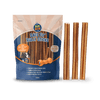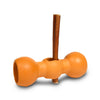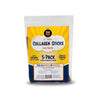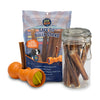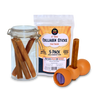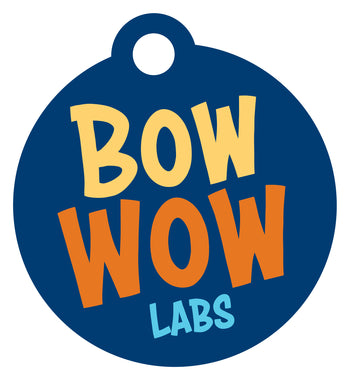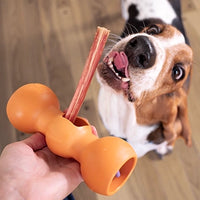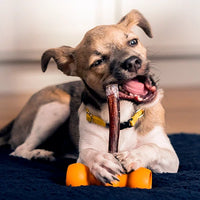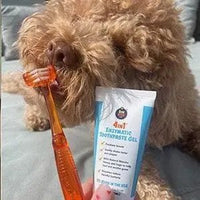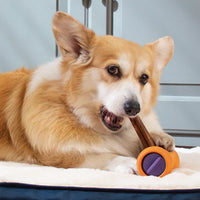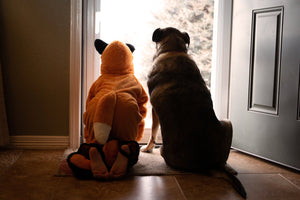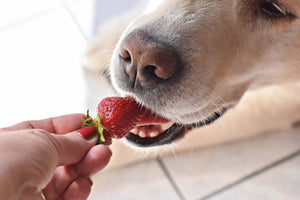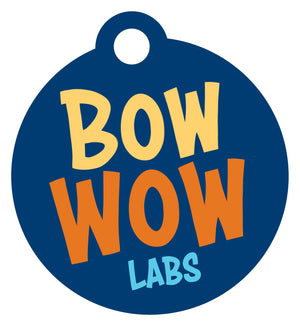I remember the exact moment I decided to stop giving my dogs bully sticks.
The second time my dog swallowed that last, dangerous bit—and I found myself anxiously waiting to make sure it passed safely and didn’t cause a blockage—I realized something: my nerves couldn’t handle it anymore.
The chew my dogs loved more than anything and that provided so many benefits had suddenly become a source of fear for me. So, I took the bully sticks away. Diego and Lola were devastated that they no longer had their favorite chew, and honestly, so was I. But I couldn’t shake the possibility of a choking emergency or a life-threatening obstruction.
Fast forward a few years, and life came full circle. I was approached by Bow Wow Labs with an invitation to join their team as their in-house Canine Nutritionist. They told me about a product they had created—a safety device specifically designed to help prevent dogs from choking on bully sticks and other chews while still allowing them to chew safely.
I was intrigued. In nearly a decade of working in the pet space, I had never seen a product like it. But before I could consider joining the team, I needed to try it for myself. I needed to ensure it did everything they promised.
So I tested it—and to be honest, my nerves grew more intense as my dogs chewed closer and closer to that final, dreaded inch. I held my breath, ready to intervene.
And BOOM—just like that, the Bow Wow Buddy® changed everything. It stopped them from swallowing that last piece—exactly as I needed it to. My dogs could finally enjoy their favorite chew again—and I could finally enjoy giving it to them.
The Bow Wow Buddy® brought bully sticks back into our lives—and this time, without the fear.
But here’s the kicker...
Many pet parents haven’t been so lucky.
Some have faced emergency surgeries. Others have experienced tragic losses. And yet, choking hazards are still not something most pet parents think—or talk—about.
That has to change.
Why We Created National Pet Choking Prevention Day
After witnessing firsthand how preventable choking incidents can be, we at Bow Wow Labs knew we had to do more. That’s why, three years ago, we established National Pet Choking Prevention Day, celebrated every year on June 22.
But this isn’t just a one-day conversation. It’s a year-round mission. Our goal is to help pet parents recognize the real and often-overlooked risks of choking—and to arm them with simple, effective tools to help prevent tragedy.

Common Household Choking Hazards for Pets
While bully sticks are the most well-known culprit, they’re far from the only risk. Dogs and cats alike are curious, mouthy and often too fast for us to stop in time. Here are just a few common items that can pose a serious choking risk:
For Dogs:
- Small rawhide pieces or broken chew toys
- Cooked bones (especially chicken or pork)
- Balls or toys that are too small for the breed
- Dental chews not suited to their chewing style
- Children’s toys, socks or underwear (yes, really!)
- String, ribbon or fabric pieces
- Food packaging
- Fruits and vegetables cut the wrong way – smooth, round pieces of foods like carrots, radishes, apples or pineapple can match the size of your pet’s airway
For Cats:
- String, yarn or tinsel
- Rubber bands or hair ties
- Small plastic parts (from toys, packaging, etc.)
- Treats or kibble pieces that are too large
- Loose buttons, beads or jewelry
- Feathers or bells from cat toys that detach easily

Tips to Help Prevent Pet Choking Incidents
Choking can happen fast—but with a little awareness, most incidents are entirely preventable. Here’s what you can do:
-
Choose the Right-Sized Toys and Chews
Always size up when in doubt. Chews and toys should be larger than your dog’s or cat’s mouth. -
Supervise Chew Time
Especially with new chews or toys, be present. Observe how your pet interacts with them. -
Secure Chews with a Safety Device
Use tools like the Bow Wow Buddy® for bully sticks, collagen sticks and other chews to help prevent choking on those last few inches. -
Pet-Proof Your Home
Get on your pet’s level—literally. Look around for small objects they could swallow. It may sound silly—but once you do it—you’ll be surprised what you find! -
Know Basic Pet First Aid
Learn how to respond if your pet does begin choking. Quick action can save lives. -
Keep Your Vet’s (& An Emergency Vet’s) Number Easily Accessible
In a crisis, every second counts. Post your emergency vet’s number on the fridge, save it in your phone favorites and let everyone in the household know where to find it. If you travel with your pet, look up the nearest emergency clinic at your destination. -
Be Mindful of How You Cut Fruits & Veggies That You Offer Your Dog
Slice them thinly or cut into irregular shapes to reduce the risk of airway blockage.

And Let’s Make Choking Prevention Part of Every Pet Parent’s Toolkit
Choking is a hidden danger—until it isn’t. Whether you’ve experienced a close call like I have, or you’re just learning about these risks now, you have the power to prevent a tragedy.
National Pet Choking Prevention Day is more than a date on the calendar—it’s a reminder that safety, awareness and prevention are part of loving our pets well and keeping them healthy.
Let’s keep the conversation going—not just on June 22nd, but every single day.
Johnna Devereaux is a Clinical Pet Nutritionist, canine wellness expert and Chief Nutrition Officer for Bow Wow Labs.
* This article is for informational purposes only. It is not, nor is it intended to be, a substitute for professional medical or veterinary advice, diagnosis, or treatment and should never be relied upon or perceived as specific medical or veterinary advice.
**The points of view expressed above are those of our clinical nutritionist and are supported by science, her education and experience. We are committed to providing the best, most straightforward, and most helpful information possible to help keep your dog happy, healthy and safe.


